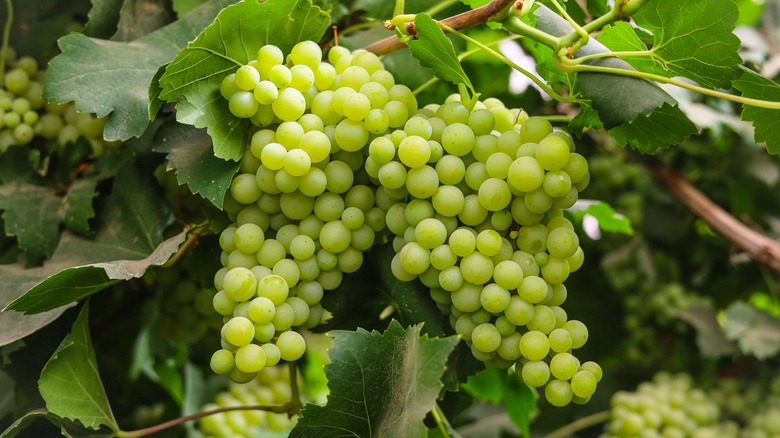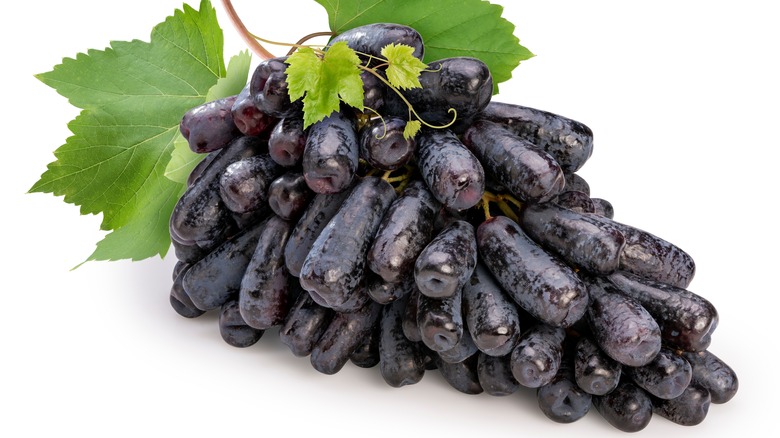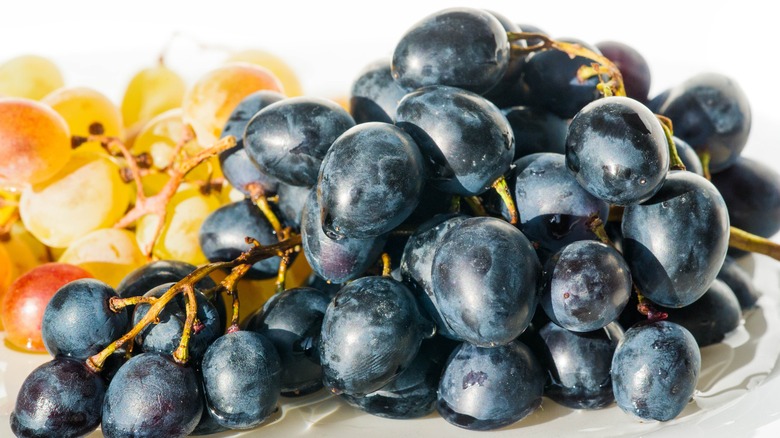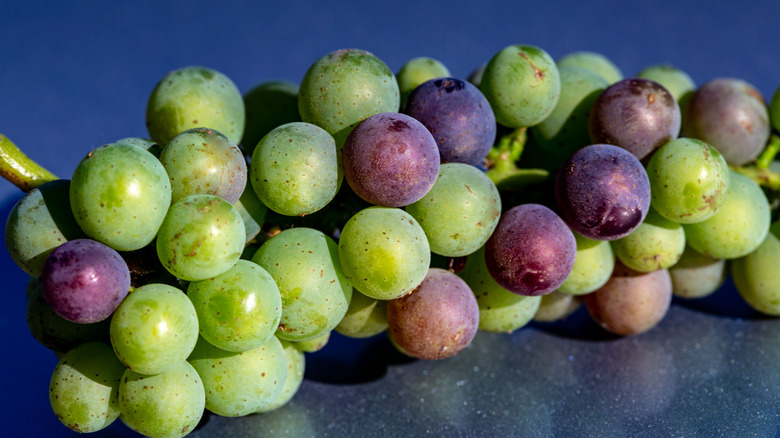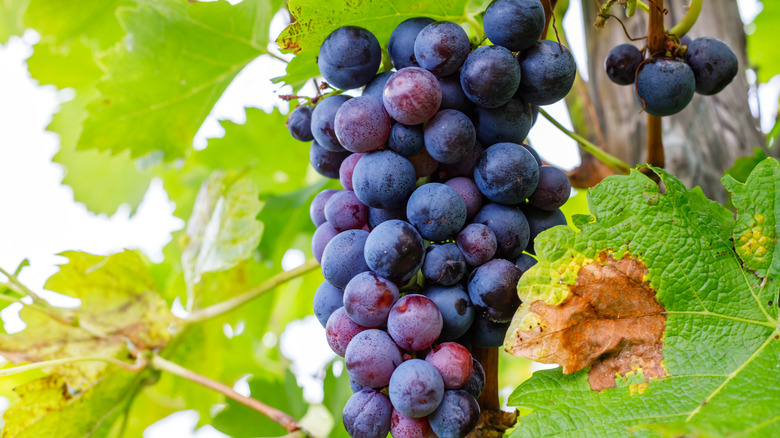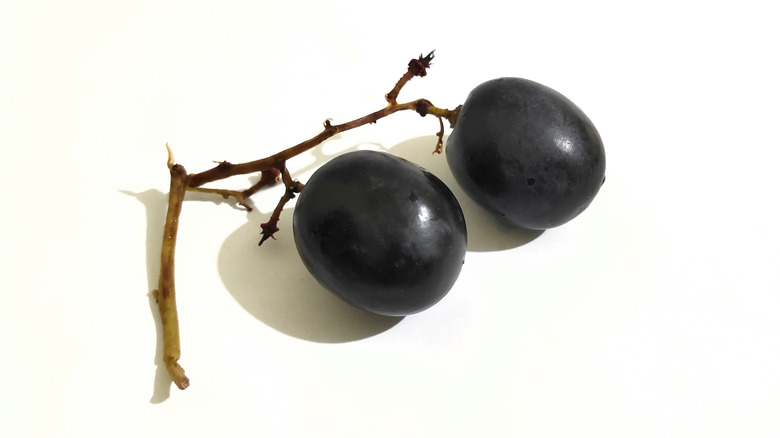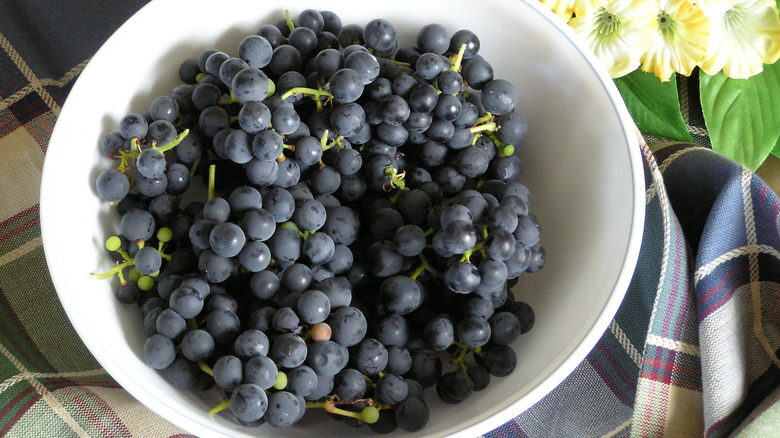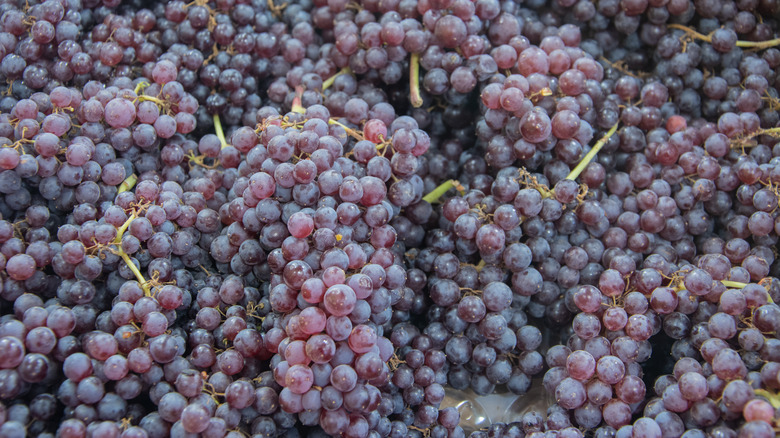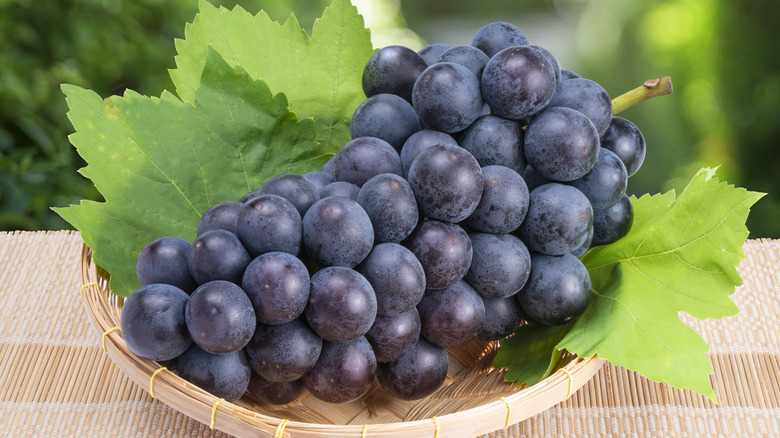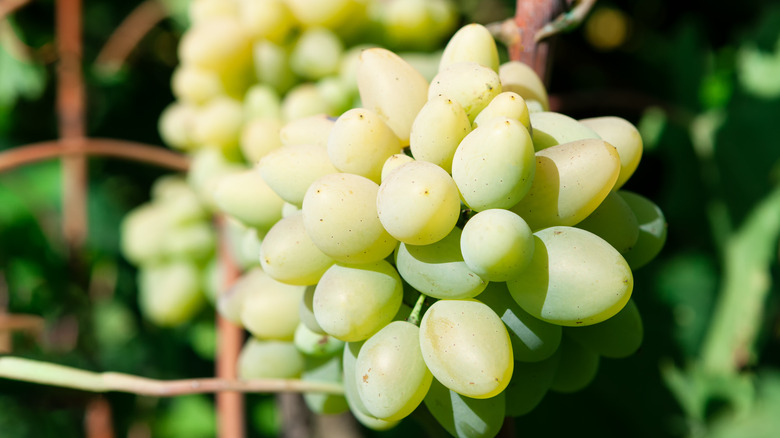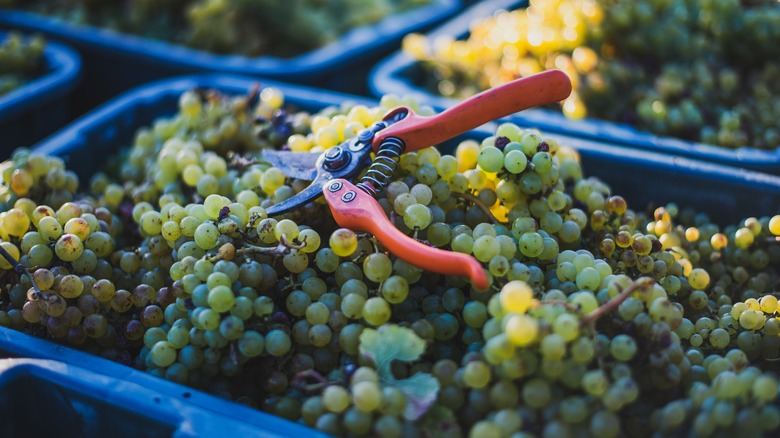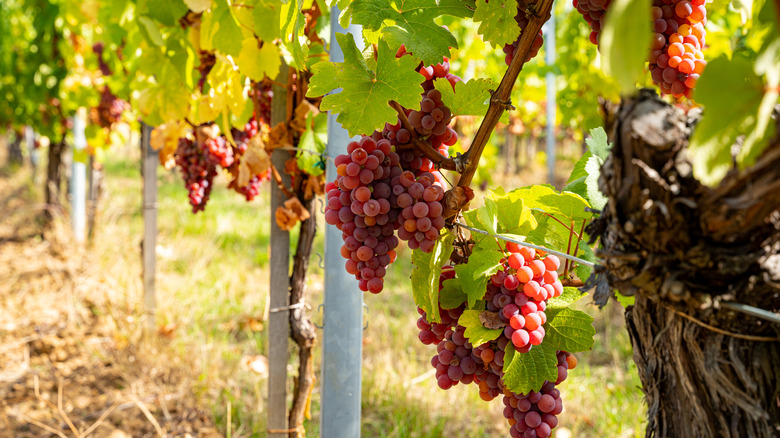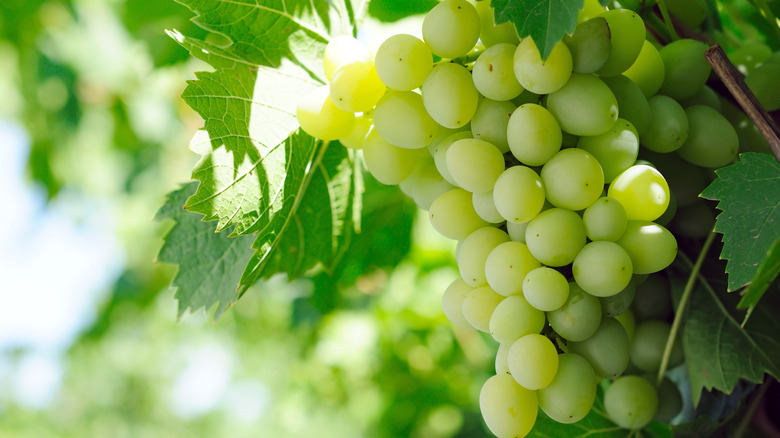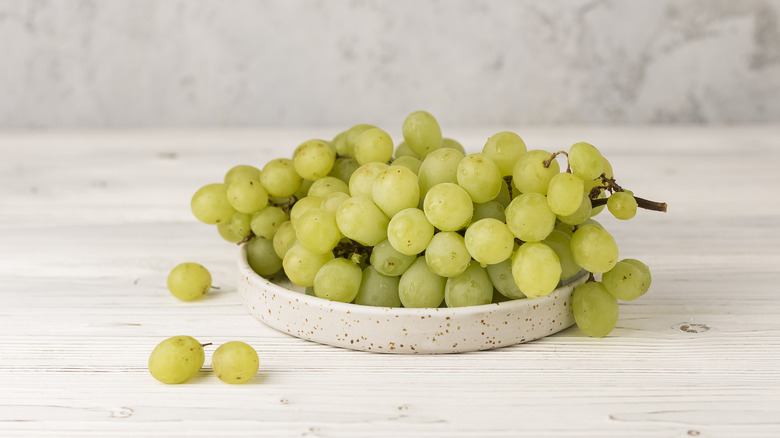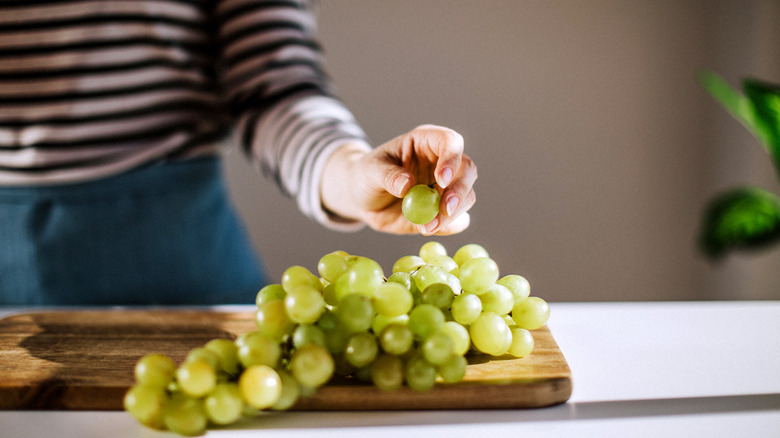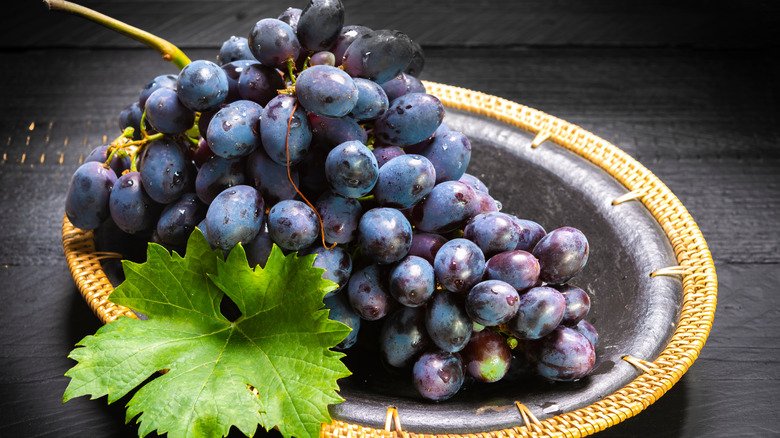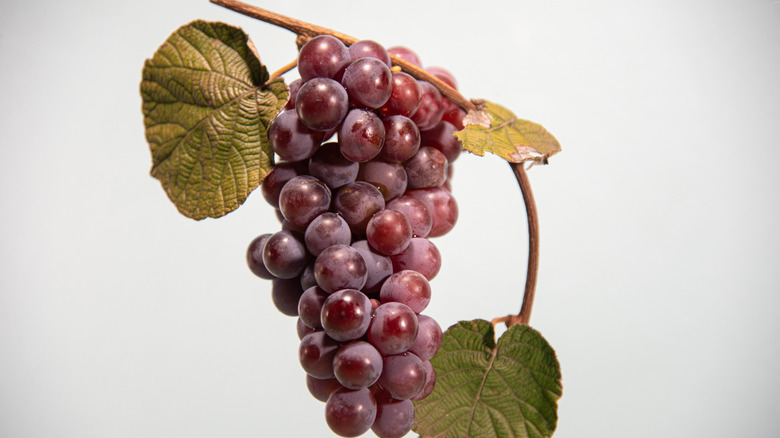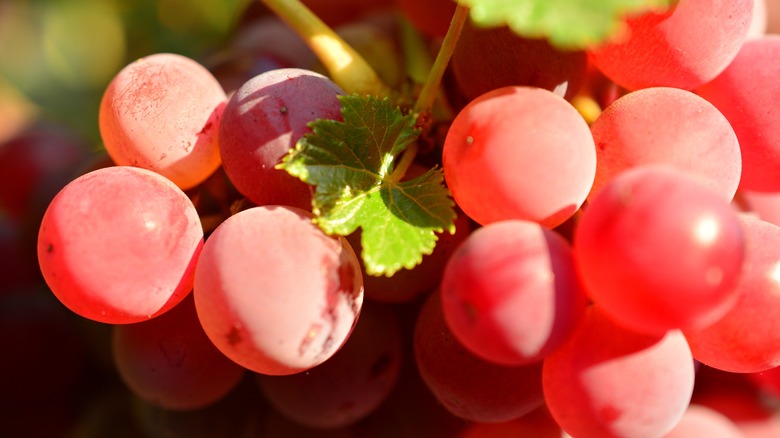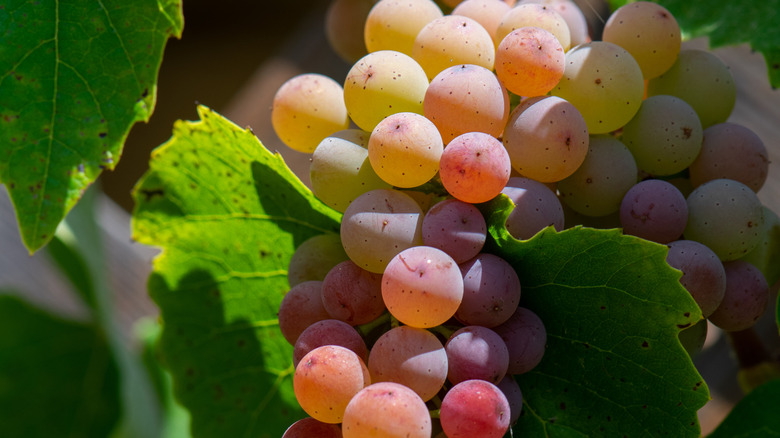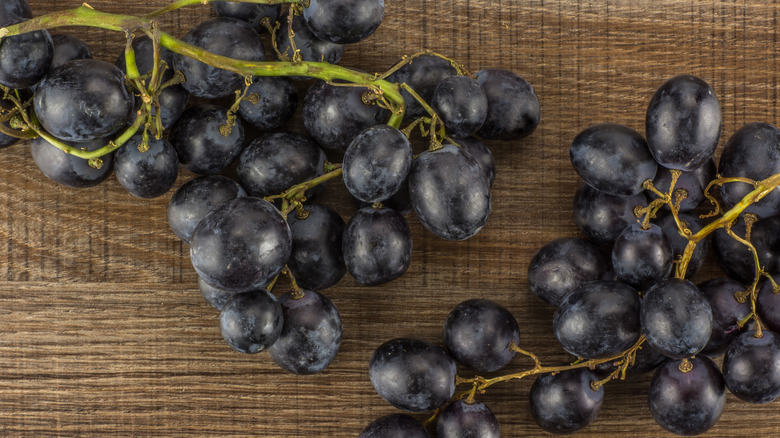21 Types Of Grapes To Know, Eat And Drink
You might think you know grapes, but given the sheer volume of variety in these juicy orbs that are eaten and pressed into beverages, there is a lot more to this fruit than what you see in the produce section and wine shop. Grapes have been cultivated domestically for thousands of years, a trade that started in the Middle East in areas including Israel, Cyprus, Egypt, Iran and Turkey, to name a few. Another fun fact: According to the Food and Agriculture Organization, the world uses 70 percent of the grapes grown to make wine. And while an estimated 10,000 types of grapes exist in the Vitaceae family, only around 1,300 of these are used in winemaking. But even if you make vino out of the fruit, that doesn't discount them from being a tasty, healthy snack option with limitless potential.
"Wine grapes are smaller than table grapes and have many seeds in them," says Peter Becraft, winemaker at Anthony Road in the Finger Lakes region of New York. "That doesn't mean that you can't enjoy them on their own or use them in making jam." In the United States, these berries (yup, they're berries) are the sixth-largest crop. All 50 states produce the fruit, with California, Washington, and New York taking the lead. According to the National Agricultural Statistics Service, the U.S. had approximately 1,049,600 acres of grape-growing land in 2014 and harvested more than 7 million tons of the fruit.
Frankly, it's overwhelming when you start to think about all the grapes out there. To get you started on your next grape adventure, check out the profiles of these 15 popular varietals. To keep it simple, we separated them by red and white. You may already be familiar with some, while others sound like they were concocted in a fantasy novel, but all are edible and delicious.
1. Moon Drops
Just this year, this elongated purple-skinned grape made its way to markets, and boy are we happy it did. The person to thank for this variety is Dr. David Cain, a plant breeder and scientist who works for the grape-growing company Grapery, developing new types. He has been working on the Moon Drop for about 15 years, cultivating the plant from a Middle Eastern sample. No, it's not a GMO fruit; Cain practices old-school plant breeding, which is why it took so long to develop this novelty.
Characteristics: Finger-like shape with dark purple, almost black skin. The flesh is firm and crunchy, giving this variety a nice snap that also helps it maintain in the refrigerator for days. It's sweet, but not too sugary, and tastes a little like grape jelly.
Where they grow: Central California
Season: Late July to late September
2. Concord
This cultivar was developed by Boston native Ephraim Wales Bull in 1849 in a small farmstead outside of Concord, Massachusetts. Bull started selling the grapes in 1854, and since then they have remained one of the most widely used fruits in the country. The famous juice we know so well appeared shortly after in 1989 thanks to New Jersey dentist Thomas Welch. This beverage remains 100 percent pure grape juice — that jammy sweetness comes solely from the fruit.
Characteristics: If you have ever had Welch's classic grape juice, then you know exactly what the Concord tastes like. Bright, sweet and full of that signature dark grape flavor. In the early fall, you might see these perfect blue-purple orbs popping up in the farmers' market. They have easy-to-peel skins and large seeds. As an added bonus, they smell fantastic!
Where they grow: The Finger Lakes region in New York, Yakima Valley in Washington, Michigan and Lake Ontario
Season: August to September
3. Pinot Noir
Classically this grape is used to make wine, and though the Burgundy region in France popularized it, growers all over the world now cultivate this vine. Lately, good samples are coming out of the Willamette Valley in Oregon and the Russian River Valley in Sonoma County, California. You also find this grape in sparkling wines, namely Champagne (more on Champagne grapes later).
Characteristics: You find this thin-skinned vitis vinifera in tight clumps of deep purple fruits. "Pinot noir has flavors and aromas of ripe cherry, wild strawberry, earthiness, and caramel," says Dreaming Tree winemaker Sean McKenzie. This is the profile you find in both the raw fruit and wine, which is why these grapes have such a following. You may also detect roses, black cherry, and currents.
Where they grow: All over the world but mainly in France, Oregon, New Zealand, and California
Season: August to September
4. Lemberger
Also known by the equally awesome name blaufränkisch, this grape is used for making dark, tannic wines with subtle spice notes. Originally this early-budding varietal grew in the Württemberg wine region of Germany, but in the last few decades the Finger Lakes of New York and the Okanagan Valley in British Columbia have been having a lot of luck with the vines.
Characteristics: The plump grapes have a dusty blue color with a tannic berry essence. If you peel the skin back, you get more sweet, dark fruit flavors. Notes of pepper tend to come out in the grape, especially when made into wine.
Where they grow: Germany, Austria, Canada and New York
Season: August to September
5. Sweet Jubilee
This grape hails from the Grapery's Flavor Promise series, and made the scene in 2012. It's one of the seeded varietals they grow, but proves so big you can cut it like an apple and just pop those suckers out. Eat them raw, sliced on a peanut butter sandwich or lightly grilled to give your salad a fruity, smoky kick.
Characteristics: You will know these grapes by the large black ovals that make up a bunch. They are sweet and firm with a clean grape flavor.
Where they grow: Central California
Season: Mid-August to early September
6. Valiant
It can't be easy to cultivate grapes in Alaska, but thanks to its durability in freezing temperatures and harsher soil conditions, the fast-growing valiant does quite well there. These large blue grapes are used for juicing, jams and as a table grape, though they can be on the sweeter (almost sugary) side.
Characteristics: These cold-weather beauties taste a lot like Concords, and have an easy-to-remove skin and high-sugar flesh. They're larger than the average table grape and aren't as astringent.
Where they grow: Alaska, Canada
Season: Late August to September
7. Champagne
No, this isn't the grape that the French make sparkling wine out of, though we understand how that might be confusing. Actually, this teeny-tiny grape's official name is the Zante currant (though it's not technically a currant) and is sometimes also called the black corinth. They are thought to have originated in Asia and/or Greece, but now are mainly grown in Europe and the United States. They are popular with chefs too, and at Rebelle in New York City chef Jessica Yang uses them alongside more standard grapes in her grape clafoutis. "Champagne grapes provide sweetness while the combination of table grapes add an element of tartness," she says.
Characteristics: These are some of the smallest berries you can find, roughly the size of a pea, which makes them perfect for decorating a plate, popping in you mouth as a snack or giving to kids. They are tender and sweet, with a pleasing crunch.
Where they grow: California, Europe, Mediterranean
Season: June to September
8. Crimson Seedless
Most of the red table grapes you see in the store are Crimson Seedless, thanks to David Ramming and Ron Tarailo of the USDA Fruit Genetics and Breeding Research Unit in Fresno, California. They bred these popular berries and released them to the public in 1989. Essentially, this is the classic grape many of us are used to, and since they have a later growing season you especially see them in the winter. Chef Yang also works with these grapes: "They add an element of tartness and have a thick skin, which keeps the juiciness and gives them a nice pop when you bite in," she says.
Characteristics: They are firm and sweet with a pleasing tartness and have a long shelf life. The color is usually a pale brick red, sometimes with greenish streaks.
Where they grow: California
Season: August to November
9. Kyoho
With fruits that get as big as a plum, these are the largest grapes you can find. In fact, the name "Kyoho" translates from Japanese to "giant-mountain grape," a moniker that stemmed from Mount Fuji. These black beauties were specially bred in the 1930s and are a cross between the Ishiharawase and Centennial grape varieties. In Japan, this grape is served for dessert or juiced and mixed into traditional chuhai cocktails.
Characteristics: Large, dark black-purple berries with a big inedible seed and thick, bitter skin. You will want to peel off the outside to enjoy the sweet fruit underneath, which has a similar taste to the Concord grape.
Where they grow: Japan
Season: July to August
10. Cotton Candy
One bite of this juicy green grape and you will understand why they are so popular. Yes, they taste just like cotton candy, but in a healthy, natural form. "We weren't breeding for a specific flavor, just grapes with a great flavor," says Jim Beagle, CEO and co-owner of Grapery, which grows these sweethearts. "It's amazing how much they taste like cotton candy." You can find this varietal trademarked under the Grapery's banner, and thus far it is only grown in California.
Characteristics: Cotton candy in grape form, hands down
Where they grow: Central California
Season: Mid-August to late September
11. Riesling
Riesling grows best in areas with cooler climates, like Austria, Germany, and the Finger Lakes in New York. "Riesling is the most versatile grape grown, giving one the potential to make wines from bone-dry to dessert wine–sweet," says Anthony Roads winemaker Peter Becraft. "The natural acidity of the grape provides structure, freshness, and balance for the grape's sugars. Riesling is wonderfully expressive of its site and the vintage it was grown in." They taste great pressed into non-alcoholic juice, too.
Characteristics: As a grape, this specimen runs on the sweet side, with floral undertones and high acidity. This fruit also picks up the terroir of the land, meaning if the soil has more minerals in it, the grapes reflect that. All of these traits make it a great grape for winemaking. Becraft, for one, calls Riesling "the best food wine ever invented."
Where they grow: Austria, New York, Germany, Canada, and Alsace
Season: August to September, though Riesling grapes for ice wine are picked at the first frost, usually October.
12. Gewürztraminer
You don't have to have wine to understand what a bottle of gewürztraminer tastes like — just pop a fresh grape in your mouth. "For me the tastiest grapes in the vineyard to munch on are the gewürztraminer grapes," says Becraft. "They really taste of the wine they turn into — so good."
Characteristics: It may surprise you find out these white grapes have a pink-red skin, nothing like the almost clear wine you tend to see in the glass. While the size proves standard for the fruit, the flavor remains less grapey, and instead comes across as soft and clean with a hint of stone fruit.
Where they grow: All over the world
Season: July to September
13. Moon Ball
Created by Dole, you won't often find these white-seeded grapes since they are only grown in South Africa and thus far production is limited. The company hopes to cultivate more in other parts of the world, so next year there might be a plethora of Moon Balls just waiting to orbit your kitchen.
Characteristics: These round hybrid grapes come out large and green, almost like an edible bouncy ball. They posses a thick skin and supple, sweet flesh that proves a bit more sugary than most table grapes.
Where they grow: South Africa
Season: February to March
14. Sultana
Also known as Thompson Seedless, these small white grapes originally hailed from the Ottoman Empire. Today, they are a favorite among chefs and are the chief fruit used to make commercial raisins. In the kitchen, prolific chef Chris Cosentino takes the little berries and gives them a blast of heat. "They are great blistered, which brings out most of their sweetness," he says. "We're using them in a great dish with squid, watermelon radish, Serrano, mint, basil, and cilantro."
Characteristics: Sultanas are small, light green oval-shaped grapes that pack a wallop of sugar. Once dried, the sugar concentrates and produces that earthy-sweet raisin flavor everyone knows. Even when you see a darker raisin, that's still a sultana.
Where they grow: Turkey, California, and Australia
Season: July to September
15. Fry Muscadine
You might not realize that this large, brown-gold orb is actually a grape, but we assure you it is. Turns out the fry muscadine has a lot in common with beach bunnies: They bronze in the sun and get a taut, crispy outside. These heat-resistant cultivars were introduced to the market in 1970 by R. Lane of the University of Georgia.
Characteristics: Coming out about the size of a cherry tomato, these fruits turn a nice gold color when ripe which just adds to their sunny sweetness.
Where they grow: Georgia
Season: September
16. Himrod
The Himrod grape, also called the fox grape, was created by the Cornell University grape breeding program in 1952. To date, it is still their most successful table grape variety. It was made by crossing Ontario and Thompson Seedless grapes. The result is a large, white, seedless grape that grows in large clusters. It is hearty and able to withstand harsh conditions in the North. Unfortunately, these tasty grapes are fairly high maintenance to grow and they are susceptible to a wide range of diseases. On a more positive note, Himrod grapes are also resilient enough to stay fresh for weeks after harvest, particularly if you clean them right and store them properly (the container matters when it comes to storing grapes).
Characteristics: Himrod grapes have a deliciously sweet flavor that could be described as honey-like. The texture is extra juicy and the flesh practically melts in your mouth. When mature, the skins are a golden yellow color. The skins are also known for their easy removal when the grape is squeezed, a trait called slipskins. Himrod grapes are especially good for eating fresh or making raisins.
Where they grow: North America
Season: Mid-August to early September
17. Thomcord
Thanks to USDA scientists, the Thomcord grape was created by crossing seedless Thompson grapes with Concord grapes in the 1980s. It took them decades to get the breed just right, but they finally managed to produce a grape that encompassed the best traits of both varieties. They have the classic grape flavor that we know and love from grape juice and jelly and are conveniently seedless. The vines are heat-tolerant and produce medium-sized grapes that range in color from blue to black to purple. The name Thomcord is pretty descriptive already (considering the grapes crossed to make it), but some producers have started calling it by other appealing names like Grape Jammers or Jelly Drops.
Characteristics: Similar to Concord grapes, Thomcord grapes are extra juicy and have a potent grape flavor (especially if you compare them to your typical year-round red and green grapes). They may be considered a specialty grape, but their jelly-like texture and sweet taste make them great for eating fresh. Just beware, they only last about a week in the fridge once harvested.
Where they grow: California
Season: August
18. Niagara
An American heirloom variety, Niagara grapes were first created by New York botanists in 1868. C. L Hoag and B. W. Clark crossed Concord and Cassady varieties and wound up with a grape that was both juicy and sweet. Named for the region in which they were first produced, Niagara grapes started being sold commercially in 1882 and have since become a big hit. Regretfully, Niagara grapes don't ship well, so they are easiest to find where they are grown — unless, of course, they've been made into wine.
Characteristics: Niagara grapes are light green to yellow in color and medium to large in size. The seedless flesh is juicy and has a crisp, foxy flavor with a fair amount of sweetness. They are great for making jellies, eating fresh, or baking. Niagara grapes are also delicious when made into sparkling and still juices or wine. However, due to their foxy yet sweet flavor, they are more prized by wine connoisseurs than your average wine drinker.
Where they grow: United States, New Zealand, Brazil, and Canada
Season: August to September
19. Flame Seedless
Whether you know them by their name or not, Flame seedless grapes are one of the most popular grapes in the United States. According to the California Garden Web, they were originally created in Fresno, California in 1961 by crossing (Cardinal x Thompson Seedless) x (Red Malaga x Tifafihi Ahmer) x (Muscat of Alexandria x Thompson Seedless). The resulting grapes thrive in warmer conditions (although they can be cultivated in regions with cooler summers as well), grow fast, and have an early ripening season.
Characteristics: Flame seedless are red table grapes that look as appealing as they taste. They are small to medium in size, have a firm texture, and are distinctly crisp with a nice crunch. Flame seedless grapes are also juicy and sweet, making them an ideal choice for enjoying fresh or drying and making raisins. Due to their popularity, they are typically easy to find in grocery stores. In most cases, it's socially acceptable to sample grapes at the store, so give them a try next time you spot them on the shelf. Just make sure to check with an employee first to be courteous and find out if they have been washed.
Where they grow: California
Season: Early July to early August
20. Canadice
Canadice grapes were a product of the New York Agricultural Experiment Station. First developed in the 1940s, they have since become quite popular. The vines are hearty, resilient, and disease-resistant. Plus, they can withstand drought conditions and cold weather quite well. As a result, they are a favorite of home and commercial cultivators alike. Closely related to Niagara and Concord grapes, Canadice grapes are as pretty as they are delicious. In addition to being edible, they have an eye-catching red color that makes them a beautiful addition to manicured landscapes.
Characteristics: Canadice grapes are medium-sized seedless grapes with a firm texture. They develop a sweet aroma when ripening in the warm sun and are easy to grow. Canadice grapes also have slipskins and are packed with sugar, resulting in a very sweet taste that is perfect for making jams, wine, or eating fresh. Underneath the sweetness, a subtle touch of spiciness can also be detected.
Where they grow: Eastern United States and Canada
Season: Early August to late September
21. Autumn Royal
A relatively new grape varietal, Autumn Royals were developed by crossing Autumn Black x C74-1 and were first introduced to the market in 1996. This late-season grape was first created in Fresno, California at the Agricultural Research Service but has since spread to reach the far corners of the globe. They are typically seedless, but on occasion, can grow something called a seed trace which is noticeable visibly but largely undetected when consumed.
Characteristics: Autumn Royal grapes are crisp, and firm to the touch. The skins are black to dark purple and have a waxy feel. Inside, you find contrasting yellow-green flesh with a potent sweet and spicy taste. The berries are also quite large. In fact, Autumn Royals are the biggest seedless grapes available. They are ideal for enjoying fresh, making jams and jellies, adding to drinks and salads, and more. Thanks to their oversized berries, you get a mouthful with every bite.
Where they grow: California, Italy, Brazil, Spain, Chile, Peru, Australia, and South Africa
Season: Late September to mid-October

